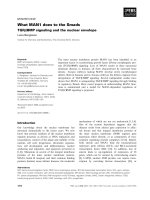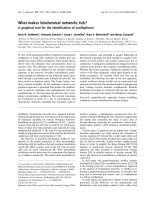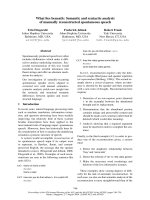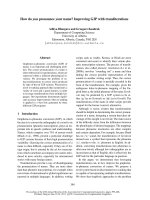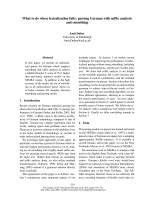Báo cáo khoa học: "What do we know about medication errors made via a CPOE system versus those made via handwritten orders"
Bạn đang xem bản rút gọn của tài liệu. Xem và tải ngay bản đầy đủ của tài liệu tại đây (31.95 KB, 2 trang )
427
CPOE = computerized physician order entry; DSS = decision support system.
Available online />Abstract
This commentary on the article by Shulman et al. examines what we
understand by ‘medication errors’, what we mean by ‘computerized
physician order entry (CPOE) systems’, how we measure errors,
and what types of errors we are ‘reducing’ with CPOE systems. As
the research of Shulman and colleagues highlights, much of the
existing research on CPOE systems does not differentiate among:
types of medication errors; consequential versus inconsequential
medication errors; CPOE systems that include/exclude formal
decision support packages; and the extent to which decision
support information is implicitly presented to physicians via the
CPOE system, for example, pull down menus with dosages. I
discuss these issues and their implications for the evaluation of
CPOE systems and of other emerging healthcare technologies.
Shulman and colleagues [1] have contributed a thoughtful
study on medication orders at an intensive care unit that
shifted from handwritten orders to a computerized physician
order entry (CPOE) system. They examine whether errors
were intercepted or not, and the frequency, severity, and
types of those errors. They explore the role of the CPOE
system in preventing and perhaps facilitating errors.
Their findings are complex. When they combined intercepted
and non-intercepted medication errors (potential and actual
errors), the CPOE system was associated with fewer errors, a
finding they repeatedly stress. When they examined major
medication errors, however, or even moderate errors that were
not intercepted by the pharmacists, their data show that all of
these more serious errors occurred only via the CPOE system.
They stress the need to consider differences in types of
errors made with CPOE systems compared to handwritten
orders. I find in Shulman et al.’s article essential questions
that are too often glossed over or assumed to have obvious
answers. Their work obliges us to re-examine our
understanding of ‘medication errors’, ‘CPOE’, how we
measure errors, and what types of errors we are ‘reducing’
with CPOE systems. I find five lessons in their work.
The complexity of medication prescribing
error
Shulman and colleagues assign medication errors into a 12
category schema that illuminates the many types of
medication prescribing errors and, key here, how these errors
vary according to the type of ordering system used. For
example, according to their study, errors of ‘dose/units/
frequency omitted on prescription’ and putting orders on
‘incorrect drug chart section’ are far more prevalent with
handwritten orders than they are with CPOE orders. But
‘wrong drug prescribed’, ‘dose errors’ and ‘required drug not
prescribed’ are more likely to occur with the CPOE system.
Dose errors, in fact, were almost twice as likely to be made
with the CPOE system; and all of the errors involving ‘required
drug not prescribed’ occurred under the CPOE system.
Beyond the comparison of paper versus computer, Shulman
et al.’s taxonomy of errors shows us that the more careful we
are in examining the types of errors occurring, the more clear
it is we are often lumping together different problems in ways
that are neither intellectually nor clinically satisfying.
The definitions of medication prescribing
errors are critical when we measure the role
of CPOE systems in preventing errors
The statement that the definitions of medication prescribing
errors are critical when we measure the role of CPOE
systems in preventing errors remains valid even if we don’t
categorize the types of errors and even though we benefit
from well-accepted error severity scales [2]. If we use
pharmacist interventions in determining errors, we are
Commentary
What do we know about medication errors made via a CPOE
system versus those made via handwritten orders?
Ross Koppel
Center for Clinical Epidemiology and Biostatistics, School of Medicine, and Sociology Department, University of Pennsylvania, Philadelphia, PA, USA
Corresponding author: Ross Koppel,
Published online: 22 August 2005 Critical Care 2005, 9:427-428 (DOI 10.1186/cc3804)
This article is online at />© 2005 BioMed Central Ltd
See related research by Shulman et al. in this issue [ />428
Critical Care October 2005 Vol 9 No 5 Koppel
measuring possible/potential errors. If we examine patients’
charts, we may see both prevented and administered errors.
(There are undoubtedly other, undetected errors.) Berger and
Kichak [3] make the critical point that studies of prescribing
errors overwhelmingly count errors that do not affect patients.
We almost always count potential errors, not actual adverse
drug events; and even then, we usually find the inconse-
quential errors.
When Berger and Kichak [3] analyzed studies by Bates et al.
[4,5] and focused on consequential errors, they found “the
reality is that no significant decrease in patient morbidity and
mortality occurred as a result of the institution of CPOE” [3].
The oft-noted 84% to 55% decrease in errors when using
CPOE [4,5] drops to a statistically insignificant 17% when
examining consequential errors. As Bates and colleagues [2]
write with intentional irony, “…it seems easiest to prevent
those [errors] that rarely cause injury.”
Thus, we must consider that among CPOE systems’ many
virtues is their ability to reduce errors that seldom reach
patients (which neither negates their many valuable
contributions nor precludes their extraordinary promise).
Delineating the purview of a CPOE system is
seldom clear
Every time Shulman et al. [1] describe their CPOE system,
they add that it is “without a decision support system” (DSS).
And while that is true, it is perhaps also too facile. As they
note, their system does not offer DSS-type warnings about
drug-drug interactions, allergies, or toxic doses; however, it
does have pull down menus indicating dosing and route, a
feature that influences physicians’ decisions. That is, CPOE
systems have implicit decision support even though it may
not be understood as such by CPOE designers or by
physicians. Also, the CPOE Shulman et al. [1] examined
included an available (but not interactive) on-line information
system with drug interactions, contraindications, side effects,
formulary, and IV administration guide.
Thus, the demarcation between CPOE systems and forms of
decision support, which might reduce or influence errors, is
seldom the bright line we imagine. When added to the reality
that many studies claiming to be of CPOE systems are
actually studies of CPOE and DSS, the waters get even more
muddied.
Shulman
et al
. posit a direct link between the
most serious medication errors and the use
of their CPOE system
Shulman et al. [1] detail, for example, how their CPOE
system’s pull down menu for dosages led to prescribing an
injection of 7 mg/kg instead of 7 mg of diamorphine. They
speculate that their CPOE’s connection to serious errors is a
“result of physicians choosing the wrong drug template,
selecting from multiple options, or as a consequence of
constructing their own drug prescriptions using pull down
menus.”
They offer more severe warnings than Koppel et al. [6].
Shulman et al. [1] write, “As clinicians embrace CPOE, they
should not make the assumption that CPOE removes errors;
in fact different types of errors emerge.”
Evaluation of CPOE systems, and of all
healthcare information technology, is mostly
terra incognita
This research reminds us that while CPOEs undoubtedly
reduce several forms of medication error, measuring such
reductions requires us to address the multifaceted reality of
error cause, error type, error certainty, error severity and,
indeed, the ability to determine that an error occurred.
Moreover, because error reduction is far from the only benefit
we anticipate from CPOEs (e.g., they also confer speedy
links to pharmacies) we presumably will seek to measure all
of these benefits and costs with some precision. But
comprehensive data or even a consensus methodology are
still forthcoming.
In summary, Shulman et al. [1] provide insights about the
consequences of CPOE systems. Their analysis offers an
uncommon balance; addressing both the benefits and
dangers of CPOEs, and highlighting differences in the types
of errors prevented and perhaps enhanced through their use.
They provide a nuanced understanding of how CPOE systems
affect medication errors and we gain useful insights into how
we might evaluate all emerging healthcare technologies.
Competing interests
The author(s) declare that they have no competing interests.
References
1. Shulman R, Singer M, Goldstone J, Bellingan G: Medication
errors: a prospective cohort study of hand-written and com-
puterized physician order entry in the ICU. Crit Care 2005, 9:
R516-R521.
2. Kaushal R, Shojania KG, Bates DW: Effects of computerized
physician order entry and clinical decision support systems
on medication safety: a systematic review. Arch Intern Med
2003, 163:1409-1416.
3. Berger RG, Kichak JP: Computerized physician order entry:
helpful or harmful. J Am Med Inform Assoc 2004, 11:100-103.
4. Bates DW, Leape LL, Cullen DJ, Laird N, Petersen LA, Teich JM,
Burdick E, Hickey M, Kleefield S, Shea B, et al.: Effect of com-
puterized physician order entry and a team intervention on
prevention of serious medication errors. J Am Med Assoc
1998, 280:1311-1316.
5. Bates DW, Teich JM, Lee JM, Seger DR: The impact of comput-
erized physician order entry on meidcaiton error prevention. J
Am Med Inform Assoc 1999, 6:313-321.
6. Koppel R, Metlay JP, Cohen A, Abaluck B, Localio AR, Kimmel
SE, Strom BL: Role of computerized physician order entry
systems in facilitating medication errors. J Am Med Assoc
2005, 293:1197-1203.


